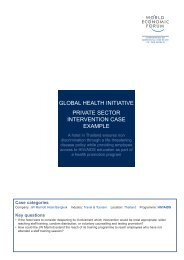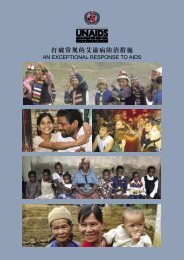X HIV/AIDS Prevention and Care in Resource-Constrained Settings
X HIV/AIDS Prevention and Care in Resource-Constrained Settings
X HIV/AIDS Prevention and Care in Resource-Constrained Settings
- No tags were found...
You also want an ePaper? Increase the reach of your titles
YUMPU automatically turns print PDFs into web optimized ePapers that Google loves.
<strong>in</strong>vest; <strong>and</strong> feedback further amplifies the impact of<strong>HIV</strong>/<strong>AIDS</strong> on economic growth.This can result <strong>in</strong> a vicious cycle <strong>in</strong> which <strong>AIDS</strong>reduces growth <strong>and</strong> <strong>in</strong>creases poverty, thereby accelerat<strong>in</strong>gthe spread of <strong>HIV</strong>. 6 These concepts have beenenumerated <strong>in</strong> a recent paper from the HarvardInstitute of International Development which suggeststhat the impact of <strong>AIDS</strong> has been systematicallyunderstated because these feedback effects have beenignored. 7 The impact on productivity due to <strong>HIV</strong>status is particularly important. The study focuses onZambia <strong>and</strong> suggests that by “stripp<strong>in</strong>g countries ofsome of their best talent <strong>and</strong> underm<strong>in</strong><strong>in</strong>g the <strong>in</strong>centiveto <strong>in</strong>vest, these difficulties may be condemn<strong>in</strong>gAfrican countries to extended periods of stagnation<strong>and</strong> decl<strong>in</strong>e.” Macroeconomic analysis is clearly enter<strong>in</strong>ga new phase.Recent work on the private sector shows that companiesalso are beg<strong>in</strong>n<strong>in</strong>g to take <strong>AIDS</strong> more seriously.But the tendency—which is economically rational—isto avoid or shift the costs of the disease, though thismay not be <strong>in</strong> the <strong>in</strong>terests of the national economy orworkforce. A classic example is a company <strong>in</strong> SouthAfrica that diversified to Eastern Europe after look<strong>in</strong>gat the impact of <strong>AIDS</strong> on its market. 8The worst impact is at the household level, <strong>and</strong>here the data are limited. Mitigation will need to focuson the household level because it is there that caremust be delivered <strong>and</strong> prevention messages may havethe most mean<strong>in</strong>g.RESPONSE TO THE<strong>HIV</strong>/<strong>AIDS</strong> EPIDEMICS:COMPONENTS FOR ANEXPANDEDCOMPREHENSIVERESPONSEEven as we recognize the devastation of <strong>AIDS</strong>dur<strong>in</strong>g the nearly two decades s<strong>in</strong>ce <strong>HIV</strong> was firstidentified, it is important to note that there has beenremarkable progress <strong>in</strong> our underst<strong>and</strong><strong>in</strong>g of variousaspects of the global <strong>HIV</strong>/<strong>AIDS</strong> p<strong>and</strong>emic. There isnow an abundance of <strong>in</strong>formation on the basicpathogenesis of the <strong>in</strong>fection; the epidemiologicadvancement of the disease around the globe; themultiple factors that determ<strong>in</strong>e vulnerability; the scopeof the p<strong>and</strong>emic’s macro- <strong>and</strong> microeconomic impacts;the development <strong>and</strong> use of highly active antiretroviraltherapies (HAART) to retard the cl<strong>in</strong>ical progressionof <strong>HIV</strong>-related disease; the f<strong>in</strong>ancial <strong>and</strong> politicalenvironment that can facilitate an effective response;<strong>and</strong>, most critically, the constellation of <strong>in</strong>terventionsneeded to achieve a national-level impact on <strong>HIV</strong>transmission.R EDUCING RISK BEHAVIORSOur ability as a global community to achievereductions <strong>in</strong> new <strong>HIV</strong> <strong>in</strong>fections is predicated on avery basic pr<strong>in</strong>ciple: We can reduce unsafe sexual <strong>and</strong>other risk behavior <strong>in</strong> a susta<strong>in</strong>able way. We nowhave ample evidence that public health programs canaffect change <strong>in</strong> the most private <strong>and</strong> basic of humanbehavior—sex. While it is impossible to attributedecl<strong>in</strong><strong>in</strong>g national <strong>HIV</strong> rates to any s<strong>in</strong>gle program, itis <strong>in</strong>creas<strong>in</strong>gly evident that people are respond<strong>in</strong>g towidespread, consistent education messages about<strong>HIV</strong>/<strong>AIDS</strong> prevention <strong>and</strong> care, <strong>and</strong> to dramatic<strong>in</strong>creases <strong>in</strong> the availability of key tools <strong>and</strong> services.In poor urban neighborhoods <strong>in</strong> the Dom<strong>in</strong>icanRepublic, for example, rates of sexually active youthdecl<strong>in</strong>ed from 73 percent <strong>in</strong> 1993 to 30 percent <strong>in</strong>1996, <strong>and</strong> rates of participation <strong>in</strong> “transactional sex”(exchang<strong>in</strong>g food, money, school fees, etc. for sex)decl<strong>in</strong>ed from 27 percent to 7 percent among males.In Bali, Indonesia, a peer education project with sexuallyactive 15- to 25-year-olds led to an <strong>in</strong>crease <strong>in</strong>consistent condom use from 22 percent to 72 percent.Susta<strong>in</strong>ed <strong>in</strong>vestments <strong>in</strong> a select number of countrieshave resulted <strong>in</strong> two k<strong>in</strong>ds of national-level success:ma<strong>in</strong>ta<strong>in</strong><strong>in</strong>g low <strong>HIV</strong> rates <strong>in</strong> countries at risk<strong>and</strong> reduc<strong>in</strong>g national-level <strong>HIV</strong> prevalence dur<strong>in</strong>g asevere generalized epidemic. Senegal has ma<strong>in</strong>ta<strong>in</strong>edone of the lowest <strong>HIV</strong> prevalence rates <strong>in</strong> sub-SaharanAfrica, with rates ris<strong>in</strong>g only slightly—from 1.2 percentfor the general adult population <strong>in</strong> 1995, to 1.8percent at the end of 1999.XX <strong>HIV</strong>/<strong>AIDS</strong> <strong>Prevention</strong> <strong>and</strong> <strong>Care</strong> <strong>in</strong> <strong>Resource</strong>-Constra<strong>in</strong>ed Sett<strong>in</strong>gs
















